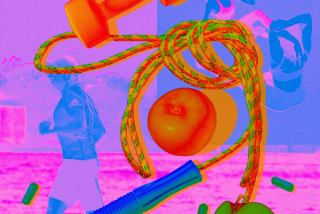One Woman’s Marmite Is Another’s Honey
- Share via
Last week, I waxed enthusiastic about the British delicacy Marmite--a dark paste made from boiled-down, salty yeast extract--and even urged Americans to slather it on bread and “enjoy!” I was taken to task for these rash words by a reader who pointed out that Americans, not raised on the spread, almost invariably find it disgusting. What, he demanded, was I thinking?
My abject apologies to anyone who suffered as a result of my urging--especially if they spread the Marmite on thick. Yet Brits such as myself love Marmite; Australians love their own brands of the stuff (Australian Marmite! Blech!). And my kid, raised in Marmite-hating territory but fed Marmite regularly, likes it too. What’s up with the rest of you?
We called Marcia Levin Pelchat, a food psychologist at Monell Chemical Senses Center in Philadelphia, to learn more about people’s food likes and dislikes. Pelchat makes her living from studying our prejudices about food, and after years in the trenches she can load up her plate with staring fish eyes or canned grasshoppers in a “nice sauce,” as she puts it.
Our suspicion about foods, she tells us, develops over time. Babies have very few food likes and dislikes, though they definitely favor sweetness and dislike bitterness. Suspicion develops later, around age 2.
It makes sense, says Pelchat, for humans to be suspicious of new foods, since in hunter-gatherer days eagerly chomping down on any new root or berry could be seriously damaging to one’s health. The trait is probably not so useful in modern culture, she adds: It’s an “evolutionary appendix,” one that causes all kinds of family conflict.
Scientific debate still rages about whether there’s a critical time in our life for the introduction of new foods if we’re ever to learn to like them. Pelchat thinks there’s a lot of flexibility. Yet monkey studies suggest that getting a varied diet early makes one more accepting of varied food later. And work by a colleague of Pelchat’s suggests that a nursing mom who eats vanilla, garlic or carrots will give her baby the taste of these things, making the baby more accepting of them later on.
Oddly, says Pelchat, people are much more prone to be suspicious and disgusted by strange animal foods than plant ones, even though strange plants are actually more likely to be loaded with some toxin or other and most strange meats--when finally tried--are apt to be described as “tasting like chicken.” That’s what she and a colleague found in an experiment where people were told to react to menus of odd-sounding fictitious foods such as “Wallamilk,” “steak from a small South American game animal” and all kinds of weirdly named fruits, breads and vegetables.
Finally, it’s not as if foods Americans love are universally loved around the globe. Only a few decades ago, Pelchat tells us, Europeans thought peanut butter was absolutely revolting. And before WWII, Asians would retch at the notion of cheese--which is, she points out, “a rotted bodily secretion from an ungulate.”
Thank you, Dr. Pelchat, and I will finish my cheese sandwich later.
Facts to Digest
Talking of food, the Web site https://www.healthscout.com offers us this dainty morsel to digest: According to an article published earlier this year in the scholarly journal Gut (one of my faves, check it out), scientists in Sydney, Australia, have done a serious study on people’s “transit times”--how long it takes to move food down the entire length of the intestines. Turns out that men with a strong streak of hypochondria have very average transit times. Not so for women who are depressed, especially if they are suppressing anger. Such women have very long transit times. Why on earth should this be? Gastroenterologists, feel free to write in with your theories.
*
If you’d like to suggest a topic, write Rosie Mestel at L.A. Times, 202 W. 1st St., Los Angeles, CA 90012 or e-mail rosie.mestel@latimes.com.






